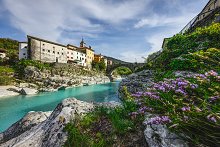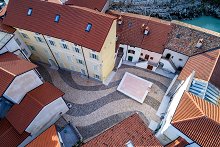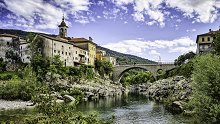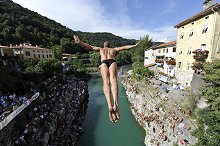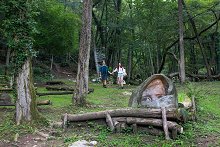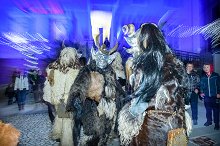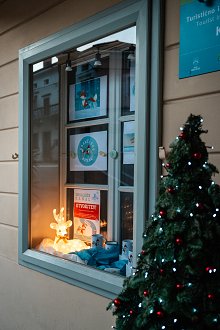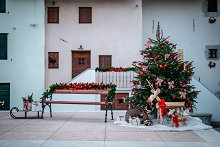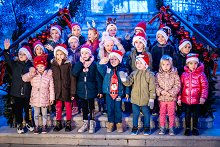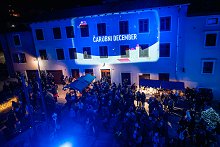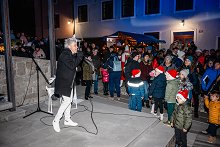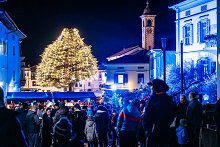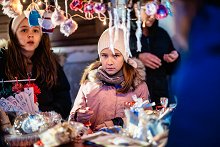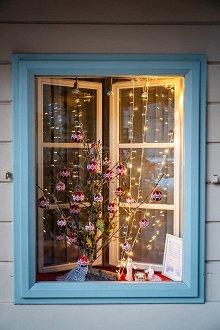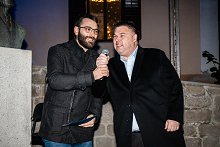Kanal
Kanal lies on both sides of the River Soča, connected to one another by means of a picturesque bridge half way between Tolmin and Nova Gorica. It has a population of 1,500 people.
The centre of the old part of Kanal, a square with Kontrada, is the place where every year the Kogojevi dnevi Festival takes place. It is celebrated in remembrance of the local composer Marij Kogoj. There is also a gallery, which was named after the local painter and graphic artist Riko Debenjak. Apart from the gallery, there is also an old house with a gate in the Gothic style.
The settlement of Kanal was established during the 12th and 13th centuries below the castle, which was mentioned for the first time in 1140. The royal landlords kept coming one after another. To mention just a few, there were the Rabatta Counts, also called the Kanal Counts. They are buried in the Marijino Celje Church near Lig above Kanal. The Rabatta Counts administered together with the Coronini Counts, called the ‘Kromberžani,’ who sold the caste to the French Duke de Blacas in 1820. During this period, Napoleon himself is believed to have spent the night in the castle. In 1903, the ‘Kramberžani’ bought the caste again. In 1469, 1477 and 1488, the Turks passed through Kanal. In that time, Kanal was surrounded by four towers called “torjoni,”. which have been preserved till today. In the centre of the square, there is Mary’s Church in the Gothic-Baroque style, which was originally built in the 13th century, and the Neptune Fountain, which represents the God of the sea. In the 19th century, Kanal got market rights due to economic development and transit position of transportation routes between Tolmin and Nova Gorica. There were also many cultural events at that time. The century, also called the Spring of Nations made a great impact on Kanal: the National reading society was built in 1867.Vivid cultural and economic activity greatly contributed to the artistic development of individuals, who, thanks to their cultural activity, became well-known artists. Among these personalities should be mentioned Valentin Stanič, priest, alpinist and poet, the composers Josip Kocijančič and Marij Kogoj, the painter Ivan Čargo, and the illustrator Riko Debenjak. The rich cultural heritage was also enriched by the conductor Anton Nanut, and Dr. Tone Ravnik, a professional writer and vet.Due to the beautiful countryside and cultural features, Kanal od Soči has been regarded as the cultural centre of the central Basin of the River Soča from the old times onwards.
The centre of the old part of Kanal, a square with Kontrada, is the place where every year the Kogojevi dnevi Festival takes place. It is celebrated in remembrance of the local composer Marij Kogoj. There is also a gallery, which was named after the local painter and graphic artist Riko Debenjak. Apart from the gallery, there is also an old house with a gate in the Gothic style.
The settlement of Kanal was established during the 12th and 13th centuries below the castle, which was mentioned for the first time in 1140. The royal landlords kept coming one after another. To mention just a few, there were the Rabatta Counts, also called the Kanal Counts. They are buried in the Marijino Celje Church near Lig above Kanal. The Rabatta Counts administered together with the Coronini Counts, called the ‘Kromberžani,’ who sold the caste to the French Duke de Blacas in 1820. During this period, Napoleon himself is believed to have spent the night in the castle. In 1903, the ‘Kramberžani’ bought the caste again. In 1469, 1477 and 1488, the Turks passed through Kanal. In that time, Kanal was surrounded by four towers called “torjoni,”. which have been preserved till today. In the centre of the square, there is Mary’s Church in the Gothic-Baroque style, which was originally built in the 13th century, and the Neptune Fountain, which represents the God of the sea. In the 19th century, Kanal got market rights due to economic development and transit position of transportation routes between Tolmin and Nova Gorica. There were also many cultural events at that time. The century, also called the Spring of Nations made a great impact on Kanal: the National reading society was built in 1867.Vivid cultural and economic activity greatly contributed to the artistic development of individuals, who, thanks to their cultural activity, became well-known artists. Among these personalities should be mentioned Valentin Stanič, priest, alpinist and poet, the composers Josip Kocijančič and Marij Kogoj, the painter Ivan Čargo, and the illustrator Riko Debenjak. The rich cultural heritage was also enriched by the conductor Anton Nanut, and Dr. Tone Ravnik, a professional writer and vet.Due to the beautiful countryside and cultural features, Kanal od Soči has been regarded as the cultural centre of the central Basin of the River Soča from the old times onwards.
